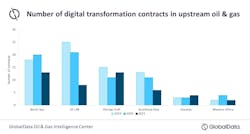Digitalization take-up growing, but with attendant risks
Offshore staff
LONDON – Majors are increasingly seeking to automate their oil and gas facilities, according to GlobalData.
Charlotte Newton, analyst on the Thematic Research team, said: “Technologies such as digital twins have the potential to be the backbone of digitalization in the sector.
“By creating 3D images and simulations of assets, systems, and processes, oil companies can imagine more sophisticated, and more reliable, machinery in oilfields both now and in the near future.”
Oil and gas analyst Ravindra Puranik added: “The oil and gas industry saw major disruption during the first waves of the COVID-19 pandemic, and companies are now looking to automate as many processes as possible to mitigate future operational risks.
“This is demonstrated by the fact that contracts activity relating to digitalization in the upstream remained resilient in the last two years, despite the pandemic-led industry downturn. Upstream hotspots in the North Sea, Norwegian Sea and Persian Gulf regions, as well as the US Lower 48 play attracted bulk of these contracts.
“Operators in Southeast Asian fields are also deploying digital oilfield technologies to optimize field development planning and boost production. There has been similar activity in the Oceania and Western Africa regions, and this may gain momentum further with improvement in energy prices.”
Puranik added that bp, Shell, Equinor, and other majors are leading the way. “Companies are likely to use digital twins and other technologies to oversee every aspect of the asset lifecycle to ensure long-term sustainability.”
Norway’s Petroleum Safety Authority (PSA) a member of The International Regulators’ Forum (IRF), said the forum has defined digital technology and automated solutions as one of its three priority topics for the petroleum industry.
“The ‘problem statement’ on digital technology and automated solutions builds on experiences that have shown that the industry in many situations fails to pay sufficient attention to the human elements when developing and adopting new technology,” said the PSA’s Linn Iren Vestly Bergh and Kristian Solheim Teigen.
Both have worked on digitalization initiatives and the associated risks, helping to develop knowledge on the topic for the PSA, also following up with the industry through supervisory activities.
“The push for increased digitalization and automation often produces systems that are increasingly interconnected and complex,” Teigen said.
“Operational systems that traditionally have operated as logical segregated and standalone units are now connected and integrated into a larger digital infrastructure. Through the IT/OT convergence, systems that were designed for high operational reliability are being connected and exposed to systems that increase the vulnerability of the system as a whole.
“We also see that new technology is an important pre-condition for successfully introducing new collaborative models and types of contracts. Decisions and the execution of tasks move from the facility to automated systems, the digital cloud and to specialist onshore centers.”
If an unforeseen situation arises, personnel must still be able to intervene and take control over complex local situations, Bergh warned.
12/07/2021
